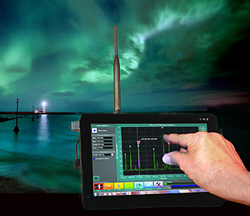
Multichannel Receivers
A number of wireless system receivers contain more than one channel – commonly two or four, and sometimes more. The benefits include increased rack density, fewer and shorter cable runs, fewer antenna connections, and less complex networking.
The Lectrosonics Venue digital hybrid system has a 1RU chassis that can hold up to six receiver modules, which can cover different RF band splits. Networking ports allow monitoring and control of each receiver, and an internal antenna combiner feeds them. The Shure ULX-D digital system is available with either two or four receivers in a 1RU chassis, with both analog and Dante digital outputs.
The Sennheiser 9000 digital system has a 4RU chassis that contains up to eight receiver modules. The receivers can cover the spectrum from 470 to 798 MHz, with digital or analog outputs, internal antenna distribution that can be daisy-chained, scanning and frequency assignment capabilities, and network connections.
Frequency Coordination
Frequency coordination used to be a complex, iterative process using hand calculations or more simplistic computerized tools. Now coordination can often be handled on the fly within the combined hardware/software solutions provided by wireless manufacturers or by using third-party software.
In a live setting, the system scans the environment to detect existing RF signals that could potentially interfere with mics, IEMs, and intercom, and then either suggests or automatically assigns clear frequencies to the equipment. Using the software interface, a visual representation of RF conditions gives a clear view of the landscape, for better decision-making.
When you’re pre-planning the wireless equipment and frequencies for an event or tour, having an informed idea of what the RF usage and interference environment is like in each venue will go a long way toward making the actual setup less surprising.
For a modest investment, RF Guru software from Stage Research allows you to calculate and save coordinated frequency plans for multiple venues, taking into account your required wireless channels, local television, and any advance information on existing wireless devices in and around the venue.
Rational Waves Intermod Assist software calculates a prioritized list of “Smart Frequency Sets” so that the most critical wireless channels – such as lead vocals – can be assigned to the most intermod-free frequencies. Sennheiser SIFM software is a proprietary solution for intermod calculations and frequency coordination.

Meanwhile, IAS (Intermodulation Analysis Software) from Professional Wireless Systems is widely used by frequency coordinators to determine potential intermodulation among the various types and brands of wireless units, as well as broadcast TV signals, encountered at large events.
The software combines a calculation engine with databases of wireless equipment frequencies and local television, so that the user enters the venue location zip code and required wireless inventory to determine a list of potentially open frequencies. IAS is in the toolkit of monitor engineers such as Mark Frink (Zak Brown Band) and Lorenzo Banda (Foreigner), and it’s also used by Epperson.

